 |
 |
 |
 |
 |
 |
 |
 |
 |
|
Page 1 of 4
|
|
|
|
Friday, August 13, 2004.
Ginowan City, Okinawa, Japan.
|
|
|
|
What started out as a fairly routine summer day on the Okinawa International University (OIU) campus turned into the worst U.S. military helicopter crash in Japan in recent years. Being summer vacation, only about 500 people were on the OIU campus. Ordinarily there would have been 5,000. Some summer session classes had just let out for the day, and students were milling about. Unbeknownst to the students, though, a U.S. Marine CH-53D Sea Stallion heavy assault transport helicopter was out of control and headed their way.
|
|
|
|
The helicopter which had taken off from Futenma air base was reportedly on a routine training mission directly over a densely populated urban residential area (!), and was headed back to the base on a path which took it over the university. Eyewitnesses including both local residents and U.S. Marines reported seeing a large section of the tail rotor assembly fall off in midair over a nearby residential neighborhood. OIU Office Chief Yasutake Kuroshima, who happened to be outside the building, took off running at the sight of the huge helicopter spiraling out of control over his head. Plummeting rapidly toward earth, the fuselage of the helicopter hit the edge of the university administration building. The rotor blades hacked large chunks of concrete from the roof of the three-story building.
|
|
|
|
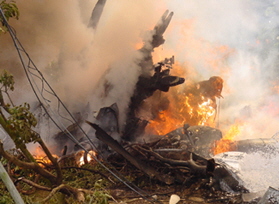 |
|
|
|
CH-53D in flames
Photo courtesy Ginowan City Fire Department
|
|
|
|
As the fuselage of the CH-53D continued its descent, the 72 foot long rotor blades cut deep gashes into the side of the reinforced concrete wall of the building. Luckily, there were no windows on that side of the building, but inside at one of the points of impact on the third floor,
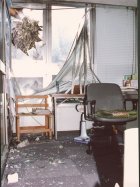 a fusillade of concrete was propelled from the wall across the office inside. Casualties were averted only because no one was in that particular office at the time. The rotor blades also cut into the wall outside the presidentfs office on the second floor. Again, by some stroke of fate President Toguchi was momentarily out of the building. a fusillade of concrete was propelled from the wall across the office inside. Casualties were averted only because no one was in that particular office at the time. The rotor blades also cut into the wall outside the presidentfs office on the second floor. Again, by some stroke of fate President Toguchi was momentarily out of the building. |
|
|
The outdoor emergency stairway also absorbed much of the impact of the flailing rotor blades, protecting the building itself. As the rotor blades slashed at the wall on one side of the building, the tail of the helicopter swung around the corner of the building and slammed into the first floor office, shattering windows and spewing shards of glass, pieces of concrete, and other debris into the accounting office. In another miraculous coincidence, no one was killed or injured because the workers in the accounting office were all on vacation. About twenty-five office workers who were at their desks in other parts of the building when the crash occurred ran for their lives.
|
|
|
 |
 |
 |
 |
 |
 |
 |
 |
 |
 |
|
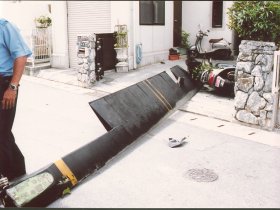 |
|
|
|
One of the huge rotor blades crushed a motorcycle in a neighborhood residentfs driveway.
|
|
|
As rotor blades and other helicopter parts broke off, they were hurled like missiles across the street where they ripped through a residential neighborhood. Concrete block walls were shattered. The mast of a TV antenna was sheared off and, still stuck to the rotor blade, fell to the street below right before the eyes of a passerby. Another section of rotor blade
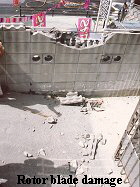 sheared a two-inch steel pipe supporting an arched trellis at the entrance of one residentfs driveway. Another blade crushed a parked motorcycle. Other pieces of debris pierced the doors and walls of houses, one fragment narrowly missing a babyfs head. Debris was found as far as 300 meters from the crash site. Miraculously, no one was killed or injured. sheared a two-inch steel pipe supporting an arched trellis at the entrance of one residentfs driveway. Another blade crushed a parked motorcycle. Other pieces of debris pierced the doors and walls of houses, one fragment narrowly missing a babyfs head. Debris was found as far as 300 meters from the crash site. Miraculously, no one was killed or injured. |
|
|
As the main fuselage of the 21 ton helicopter slammed into the ground, the force of the impact sent shock waves through the building. Some people working in other rooms in the building initially thought it was an earthquake. Immediately after impact the CH-53D burst into flames, sending clouds of acrid smelling black smoke billowing skyward.
|
|
|
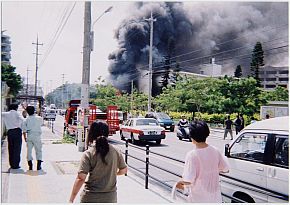 |
|
|
|
Toxic smoke billowing from the crash site
|
|
|
|
The helicopter crashed just over 100 meters from a gas station, and about 150 meters from a day-care center and an elementary school.
It cannot be ascertained exactly how many people were aboard, but the U.S. military reported a crew of three. A typical crew on a CH-53D is six: two officers (pilots) and four enlisted (2 engineers, 2 gunners)*. The control tower must have known the aircraft was going down, because Marines started arriving on the scene almost immediately after the aircraft went down. Recordings of the control tower transmissions have yet to be released.
The Marines had apparently trained in preparation for just such an accident. The Pacific Stars and Stripes newspaper (27 Aug. 2004, p. 3) credited Lance Cpl. Christopher Teague with selflessly risking his life to rescue the pilot. As he and other Marines pulled an injured pilot and other crew members to safety around the corner of the building, the helicopter began to explode. Witnesses reported a series of five or six explosions. The US Naval Hospital initially reported that one pilot was in serious condition, but the number, fate, and identities of the helicopter crew members remain a mystery.
|
|
|
Read more...
Part 2 - The Invasion
|
|
|



 a fusillade of concrete was propelled from the wall across the office inside. Casualties were averted only because no one was in that particular office at the time. The rotor blades also cut into the wall outside the presidentfs office on the second floor. Again, by some stroke of fate President Toguchi was momentarily out of the building.
a fusillade of concrete was propelled from the wall across the office inside. Casualties were averted only because no one was in that particular office at the time. The rotor blades also cut into the wall outside the presidentfs office on the second floor. Again, by some stroke of fate President Toguchi was momentarily out of the building.
 sheared a two-inch steel pipe supporting an arched trellis at the entrance of one residentfs driveway. Another blade crushed a parked motorcycle. Other pieces of debris pierced the doors and walls of houses, one fragment narrowly missing a babyfs head. Debris was found as far as 300 meters from the crash site. Miraculously, no one was killed or injured.
sheared a two-inch steel pipe supporting an arched trellis at the entrance of one residentfs driveway. Another blade crushed a parked motorcycle. Other pieces of debris pierced the doors and walls of houses, one fragment narrowly missing a babyfs head. Debris was found as far as 300 meters from the crash site. Miraculously, no one was killed or injured.